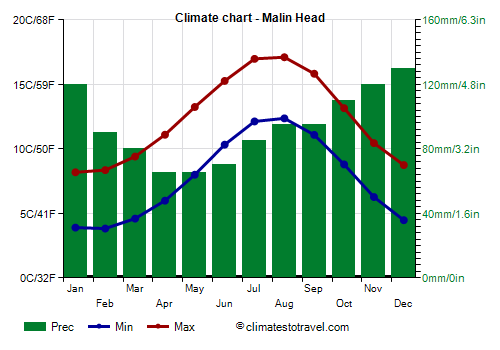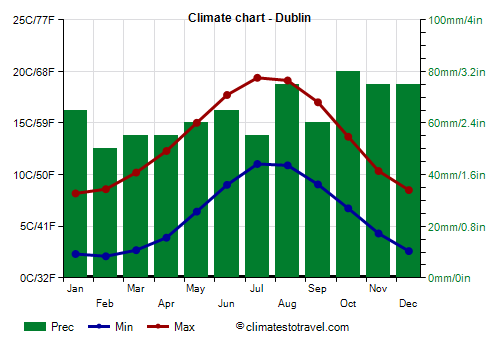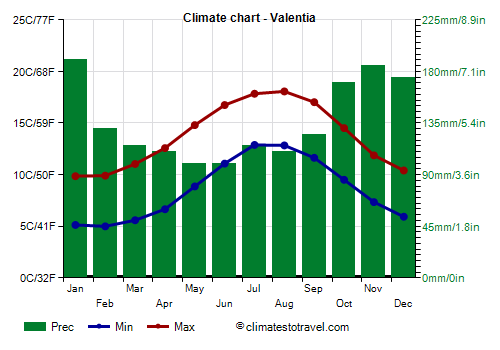Select units of measurement for the temperature and rainfall tables (metric or imperial).
Average weather, temperature, rainfall, sunshine
Ireland has an
oceanic climate, cool and damp, cloudy and rainy throughout the year. Both the diurnal and the annual temperature ranges are narrow, so both the summer heat and the winter frost are rare.
The island of Ireland is located in Western Europe, on the Atlantic Ocean, between 51 and 55 degrees north latitude.
Temperatures do not vary much in the island; however, the western coasts are milder in winter and cooler in summer. The southwest coast is particularly mild in winter.
In Ireland, Atlantic weather fronts move relentlessly one after another over the country, resulting in a rapid succession of cloudiness and sunshine, rain showers and subsequent improvements. Days with completely clear skies are rare: the weather is more likely to be
variable or unstable, and in the interludes between disturbances you can expect, rather than clear skies, clouds running in the sky.
The
sun shines for about 1,300 hours a year in the west, 1,450 hours in Dublin, on the east coast, and up to 1,550 hours on the south-east coast (see Waterford). The sky in Ireland is often cloudy, so the sun is rarely seen; however, the sunniest month (compared to the length of the days) is May.
The
wind in Ireland is frequent and lively, although it is generally stronger between late autumn and early spring. The windiest area is the northern one (Donegal), which is literally windswept; the (relatively) least windy area is the inland south-eastern one (see Thurles, Kilkenny).
Rainfall is frequent throughout the island, but especially along the west coast, where it rains on average even more than once every two days; rainfall is more abundant on the slopes of the western hills, where it exceeds 2,000 millimeters (80 inches) per year. In Galway, on the west coast, 1,150 mm (45.5 in) of rain fall per year; in Cork, on the south coast, 1,200 mm (48 in). The least rainy area is the eastern one, where Dublin is located: here the rainfall is around 760 mm (30 in) per year.
The climate in detail
The seasons
Winter, from December to February, is quite cold but not freezing. The sky is often cloudy, the rains are frequent, and the most intense low pressure systems can cause wind storms. Temperatures are slightly above freezing during the night, while during the day they range from 7/8 °C (45/46 °F) in inland areas, to 8/10 °C (46/50 °F) along the coasts.
On milder periods, when southerly air masses reach Ireland, the temperature can reach 15 °C (59 °F) even in winter.
In Ireland, there are no major mountain ranges, however, in the
hills to the south of Dublin (Wicklow Mountains) and more rarely in the western highlands, with reach about a thousand meters (3,300 feet) in height, during winter the rain can turn into snow above 400/500 meters (1,300/1,600 feet).
Cold waves are rare, and are usually short-lived because after a while the westerlies start to blow again. In most cases, on clear nights there can be light frosts, and nothing more. Night temperatures drop below freezing (0 °C or 32 °F), usually by a few degrees, for about 35 days in Dublin, 20 days on the southeast coast and 7 days on the southwest coast.
Snow is quite rare as well: on average, it falls for a few days in a year, and may not occur for an entire winter.
However, occasionally there can be a more intense cold spell than usual, during which the temperature can go down to -10 °C (14 °F) or even below. In December 2010, the temperature dropped to -15 °C (5 °F) in the inland north-central areas, for example in Claremorris, but also on the western outskirts of Dublin, it also dropped to -11.5 °C (11 °F) in Limerick, to -12 °C (10.5 °F) in Dublin, and to -7 °C (19.5 °F) in Cork, on the south coast.
 Spring
Spring, from March to May, is initially cold, and remains very cool or cold still in April, and sometimes in May; usually the temperature becomes quite mild only by the second half of May, when, however, nights can still be quite cold. In return, spring is the (relatively) least rainy season and the sunniest of the year.
In
Summer, from June to August, temperatures are cool: average highs are around 17/18 °C (63/64 °F) in the north, and around 19/20 °C (66/68 °F) in the rest of Ireland. The rains are also frequent in this season.
However, quite rarely, there may be periods, usually short-lived, with sunny weather and pleasantly warm temperatures, when the Azores High moves over the country. In these cases, the temperature can reach or exceed 25 °C (77 °F), though it almost never reaches 30 °C (86 °F).
The
heat record is 27 °C (80.5 °F) in Malin Head on the north coast, recorded in June 1976, and 29.7 °C (85.5 °F) in Cork, recorded in July 1989. In Galway, on the west coast, the temperature reached 30.5 °C (87 °F) in June 1976, while in a Dublin park, it reached 33 °C (91.5 °F) in July 2022. In Kilkenny, in the south, it reached 31.5 °C (88.7 °F) in July 1983. In Limerick, at some distance from the west coast, it reached 32 °C (89.6 °F) in June 2018.
Autumn, from September to November, is cloudy and rainy, at times windy, with little room for sunshine.
The cities
Malin Head

The
northern coast, mild enough but windy in winter, is the coolest part of Ireland in summer.
In Malin Head, the northernmost point of the island, in County Donegal, the average temperature in January and February is 6 °C (42.5 °F), while in July and August it's 14.5 °C (58.5 °F).
The records are -6 °C (21 °F, set in January 1979 and February 1986) and 27 °C (80.5 °F, set on July 1st, 1976).
In Malin Head, the rains are not very abundant, around 1,100 mm (44 inches) per year, but they are frequent all year round. However, the least rainy season is spring.
Dublin
 Dublin
Dublin, the capital city, is located on the east coast, which is slightly colder in winter, while in summer it is one of the mildest areas of the country.
As mentioned, the Dublin area is also the least rainy of the island, although the rains are quite frequent all year round.
The
sea in Ireland is not inviting for swimming, in fact the water temperature does not go above 15/16 °C (59/61 °F) in July and August.

Valentia

In winter, the
south-west coast is the mildest area of Ireland, with very rare frosts, so much so that even sub-tropical plant species can thrive.
On the small island of Valentia, in County Kerry, the average temperature is 7.5 °C (45.5 °F) in January and February, and 15.5 °C (60 °F) in July and August.
The records are -7.7 °C (18 °F, December 2010) and 28.5 °C (83 °F, late June 2018).
In Valentia, directly exposed to wet currents from the south-west, the rains are abundant, around 1,600 mm (63 in) per year.
On the southern coast of Ireland we find the second city,
Cork, while a short distance from the coast we find
Waterford.
When to go
The best time to visit Ireland is the summer,
from June to August, since it is the mildest of the year: the rains are frequent, the air is often very cool (especially in June), it's better to bring a jacket and umbrella (or rather a raincoat as it often rains in the wind), but the days are long, and you can hope to see the sun peeking through the clouds.
In September, the temperatures are still acceptable, but the sky is often cloudy, and the days are shorter than in the previous months.
What to pack
In
winter: bring warm clothes, such as a sweater, a coat, a raincoat.
In
summer: bring clothes for spring and autumn, a jacket and a sweater, a raincoat or umbrella.
Climate data - Ireland
| Cork |
|---|
|
| Jan | Feb | Mar | Apr | May | Jun | Jul | Aug | Sep | Oct | Nov | Dec |
|---|
| Min temp. | 3 | 3 | 4 | 5 | 7 | 10 | 12 | 11 | 10 | 8 | 5 | 4 |
|---|
| Max temp. | 8 | 9 | 10 | 12 | 15 | 17 | 19 | 18 | 17 | 13 | 10 | 9 |
|---|
| Precip. | 130 | 100 | 100 | 75 | 80 | 80 | 80 | 95 | 95 | 140 | 120 | 135 |
|---|
| Prec. days | 16 | 13 | 14 | 11 | 12 | 10 | 10 | 11 | 11 | 15 | 14 | 15 |
|---|
| Humidity | 89% | 87% | 85% | 82% | 81% | 81% | 84% | 84% | 86% | 88% | 90% | 90% |
|---|
| Day length | 8 | 10 | 12 | 14 | 16 | 17 | 16 | 14 | 13 | 11 | 9 | 8 |
|---|
| Sun hours | 2 | 2 | 3 | 5 | 6 | 6 | 5 | 5 | 4 | 3 | 2 | 2 |
|---|
| Sea temp | 10 | 10 | 10 | 10 | 12 | 14 | 16 | 17 | 16 | 14 | 12 | 11 |
|---|
| Dublin |
|---|
|
| Jan | Feb | Mar | Apr | May | Jun | Jul | Aug | Sep | Oct | Nov | Dec |
|---|
| Min temp. | 2 | 2 | 3 | 4 | 6 | 9 | 11 | 11 | 9 | 7 | 4 | 3 |
|---|
| Max temp. | 8 | 9 | 10 | 12 | 15 | 18 | 19 | 19 | 17 | 14 | 10 | 9 |
|---|
| Precip. | 65 | 50 | 55 | 55 | 60 | 65 | 55 | 75 | 60 | 80 | 75 | 75 |
|---|
| Prec. days | 13 | 10 | 11 | 11 | 11 | 10 | 11 | 12 | 10 | 12 | 12 | 13 |
|---|
| Humidity | 86% | 84% | 82% | 80% | 78% | 78% | 80% | 81% | 83% | 84% | 87% | 87% |
|---|
| Day length | 8 | 10 | 12 | 14 | 16 | 17 | 16 | 15 | 13 | 10 | 9 | 8 |
|---|
| Sun hours | 2 | 3 | 4 | 5 | 6 | 6 | 5 | 5 | 4 | 3 | 2 | 2 |
|---|
| Sea temp | 9 | 8 | 8 | 9 | 10 | 13 | 15 | 16 | 15 | 14 | 12 | 10 |
|---|
| Galway |
|---|
|
| Jan | Feb | Mar | Apr | May | Jun | Jul | Aug | Sep | Oct | Nov | Dec |
|---|
| Min temp. | 4 | 4 | 5 | 6 | 8 | 11 | 13 | 12 | 10 | 8 | 5 | 4 |
|---|
| Max temp. | 9 | 9 | 11 | 13 | 16 | 18 | 20 | 19 | 17 | 14 | 11 | 9 |
|---|
| Precip. | 115 | 95 | 90 | 60 | 70 | 80 | 70 | 110 | 95 | 130 | 125 | 120 |
|---|
| Prec. days | 15 | 14 | 16 | 12 | 12 | 12 | 12 | 15 | 13 | 17 | 17 | 17 |
|---|
|
|
|
| Sea temp | 10 | 10 | 10 | 10 | 12 | 14 | 15 | 16 | 15 | 14 | 12 | 11 |
|---|
| Kilkenny |
|---|
|
| Jan | Feb | Mar | Apr | May | Jun | Jul | Aug | Sep | Oct | Nov | Dec |
|---|
| Min temp. | 2 | 2 | 3 | 5 | 7 | 10 | 11 | 11 | 9 | 7 | 4 | 3 |
|---|
| Max temp. | 9 | 9 | 11 | 13 | 16 | 19 | 20 | 20 | 18 | 14 | 11 | 9 |
|---|
| Precip. | 85 | 60 | 65 | 65 | 65 | 60 | 60 | 75 | 75 | 95 | 90 | 85 |
|---|
| Prec. days | 14 | 12 | 11 | 11 | 13 | 10 | 12 | 11 | 11 | 13 | 14 | 13 |
|---|
|
|
| Sun hours | 2 | 2 | 3 | 5 | 6 | 5 | 5 | 5 | 4 | 3 | 2 | 2 |
|---|
|
| Limerick |
|---|
|
| Jan | Feb | Mar | Apr | May | Jun | Jul | Aug | Sep | Oct | Nov | Dec |
|---|
| Min temp. | 3 | 3 | 4 | 6 | 8 | 11 | 13 | 12 | 11 | 8 | 6 | 4 |
|---|
| Max temp. | 9 | 10 | 11 | 14 | 16 | 18 | 20 | 19 | 18 | 14 | 11 | 9 |
|---|
| Precip. | 105 | 90 | 75 | 65 | 65 | 70 | 75 | 85 | 80 | 95 | 105 | 115 |
|---|
| Prec. days | 17 | 14 | 14 | 12 | 13 | 12 | 13 | 14 | 13 | 15 | 17 | 17 |
|---|
| Humidity | 86% | 84% | 80% | 77% | 75% | 76% | 79% | 80% | 82% | 84% | 87% | 87% |
|---|
| Day length | 8 | 10 | 12 | 14 | 16 | 17 | 16 | 15 | 13 | 10 | 9 | 8 |
|---|
| Sun hours | 2 | 2 | 3 | 5 | 6 | 5 | 5 | 5 | 4 | 3 | 2 | 1 |
|---|
|
| Malin Head |
|---|
|
| Jan | Feb | Mar | Apr | May | Jun | Jul | Aug | Sep | Oct | Nov | Dec |
|---|
| Min temp. | 4 | 4 | 5 | 6 | 8 | 10 | 12 | 12 | 11 | 9 | 6 | 4 |
|---|
| Max temp. | 8 | 8 | 9 | 11 | 13 | 15 | 17 | 17 | 16 | 13 | 10 | 9 |
|---|
| Precip. | 120 | 90 | 80 | 65 | 65 | 70 | 85 | 95 | 95 | 110 | 120 | 130 |
|---|
| Prec. days | 19 | 16 | 15 | 13 | 12 | 12 | 16 | 16 | 15 | 17 | 20 | 19 |
|---|
|
|
| Sun hours | 1 | 2 | 3 | 5 | 7 | 6 | 5 | 5 | 4 | 3 | 2 | 1 |
|---|
|
| Mullingar |
|---|
|
| Jan | Feb | Mar | Apr | May | Jun | Jul | Aug | Sep | Oct | Nov | Dec |
|---|
| Min temp. | 3 | 2 | 3 | 4 | 7 | 10 | 11 | 11 | 9 | 7 | 5 | 3 |
|---|
| Max temp. | 7 | 8 | 10 | 12 | 15 | 18 | 19 | 19 | 17 | 13 | 10 | 7 |
|---|
| Precip. | 90 | 70 | 80 | 60 | 70 | 70 | 60 | 80 | 75 | 100 | 80 | 95 |
|---|
| Prec. days | 19 | 17 | 20 | 15 | 16 | 16 | 16 | 17 | 17 | 19 | 18 | 19 |
|---|
|
|
| Sun hours | 2 | 3 | 3 | 5 | 6 | 5 | 5 | 5 | 4 | 3 | 2 | 2 |
|---|
|
| Valentia |
|---|
|
| Jan | Feb | Mar | Apr | May | Jun | Jul | Aug | Sep | Oct | Nov | Dec |
|---|
| Min temp. | 5 | 5 | 6 | 7 | 9 | 11 | 13 | 13 | 12 | 10 | 7 | 6 |
|---|
| Max temp. | 10 | 10 | 11 | 13 | 15 | 17 | 18 | 18 | 17 | 15 | 12 | 10 |
|---|
| Precip. | 190 | 130 | 115 | 110 | 100 | 100 | 115 | 110 | 125 | 170 | 185 | 175 |
|---|
| Prec. days | 21 | 18 | 16 | 14 | 14 | 13 | 16 | 16 | 16 | 18 | 21 | 20 |
|---|
|
|
| Sun hours | 2 | 2 | 3 | 5 | 6 | 6 | 4 | 5 | 4 | 3 | 2 | 1 |
|---|
|
| Waterford |
|---|
|
| Jan | Feb | Mar | Apr | May | Jun | Jul | Aug | Sep | Oct | Nov | Dec |
|---|
| Min temp. | 3 | 3 | 4 | 6 | 8 | 11 | 13 | 12 | 10 | 8 | 5 | 4 |
|---|
| Max temp. | 9 | 9 | 11 | 13 | 16 | 19 | 21 | 20 | 18 | 15 | 12 | 10 |
|---|
| Precip. | 105 | 70 | 80 | 75 | 70 | 65 | 70 | 80 | 80 | 120 | 110 | 110 |
|---|
| Prec. days | 15 | 11 | 12 | 11 | 11 | 9 | 10 | 11 | 10 | 14 | 13 | 14 |
|---|
| Humidity | 90% | 86% | 83% | 80% | 79% | 80% | 80% | 82% | 85% | 88% | 90% | 91% |
|---|
| Day length | 8 | 10 | 12 | 14 | 16 | 17 | 16 | 15 | 13 | 11 | 9 | 8 |
|---|
| Sun hours | 2 | 3 | 4 | 6 | 7 | 6 | 6 | 6 | 5 | 3 | 2 | 2 |
|---|
| Sea temp | 10 | 9 | 9 | 9 | 11 | 14 | 16 | 16 | 16 | 14 | 12 | 11 |
|---|
See also the
temperatures month by month